2015 DODGE GRAND CARAVAN ESP
[x] Cancel search: ESPPage 639 of 703
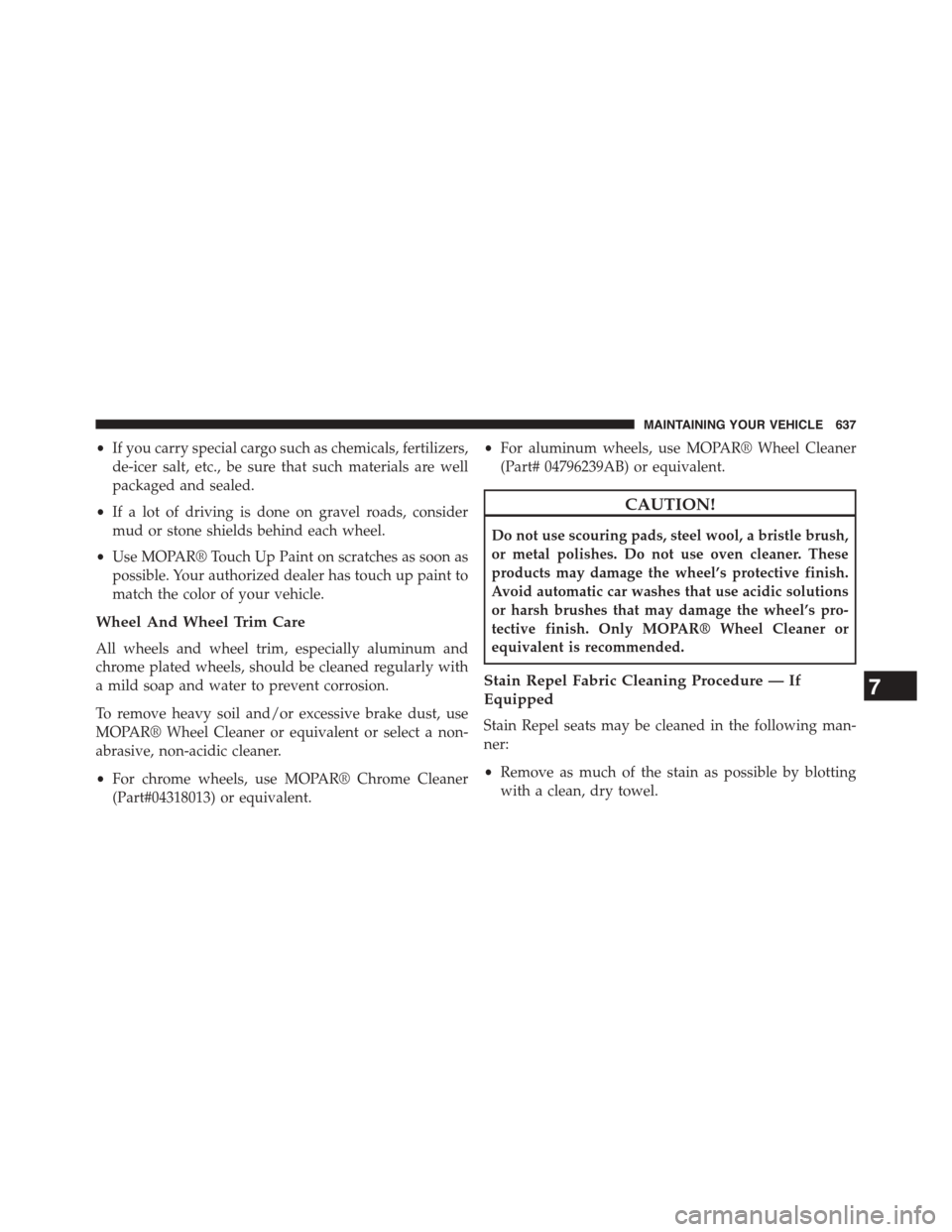
•If you carry special cargo such as chemicals, fertilizers,
de-icer salt, etc., be sure that such materials are well
packaged and sealed.
•If a lot of driving is done on gravel roads, consider
mud or stone shields behind each wheel.
•Use MOPAR® Touch Up Paint on scratches as soon as
possible. Your authorized dealer has touch up paint to
match the color of your vehicle.
Wheel And Wheel Trim Care
All wheels and wheel trim, especially aluminum and
chrome plated wheels, should be cleaned regularly with
a mild soap and water to prevent corrosion.
To remove heavy soil and/or excessive brake dust, use
MOPAR® Wheel Cleaner or equivalent or select a non-
abrasive, non-acidic cleaner.
•For chrome wheels, use MOPAR® Chrome Cleaner
(Part#04318013) or equivalent.
•For aluminum wheels, use MOPAR® Wheel Cleaner
(Part# 04796239AB) or equivalent.
CAUTION!
Do not use scouring pads, steel wool, a bristle brush,
or metal polishes. Do not use oven cleaner. These
products may damage the wheel’s protective finish.
Avoid automatic car washes that use acidic solutions
or harsh brushes that may damage the wheel’s pro-
tective finish. Only MOPAR® Wheel Cleaner or
equivalent is recommended.
Stain Repel Fabric Cleaning Procedure — If
Equipped
Stain Repel seats may be cleaned in the following man-
ner:
•Remove as much of the stain as possible by blotting
with a clean, dry towel.
7
MAINTAINING YOUR VEHICLE 637
Page 641 of 703
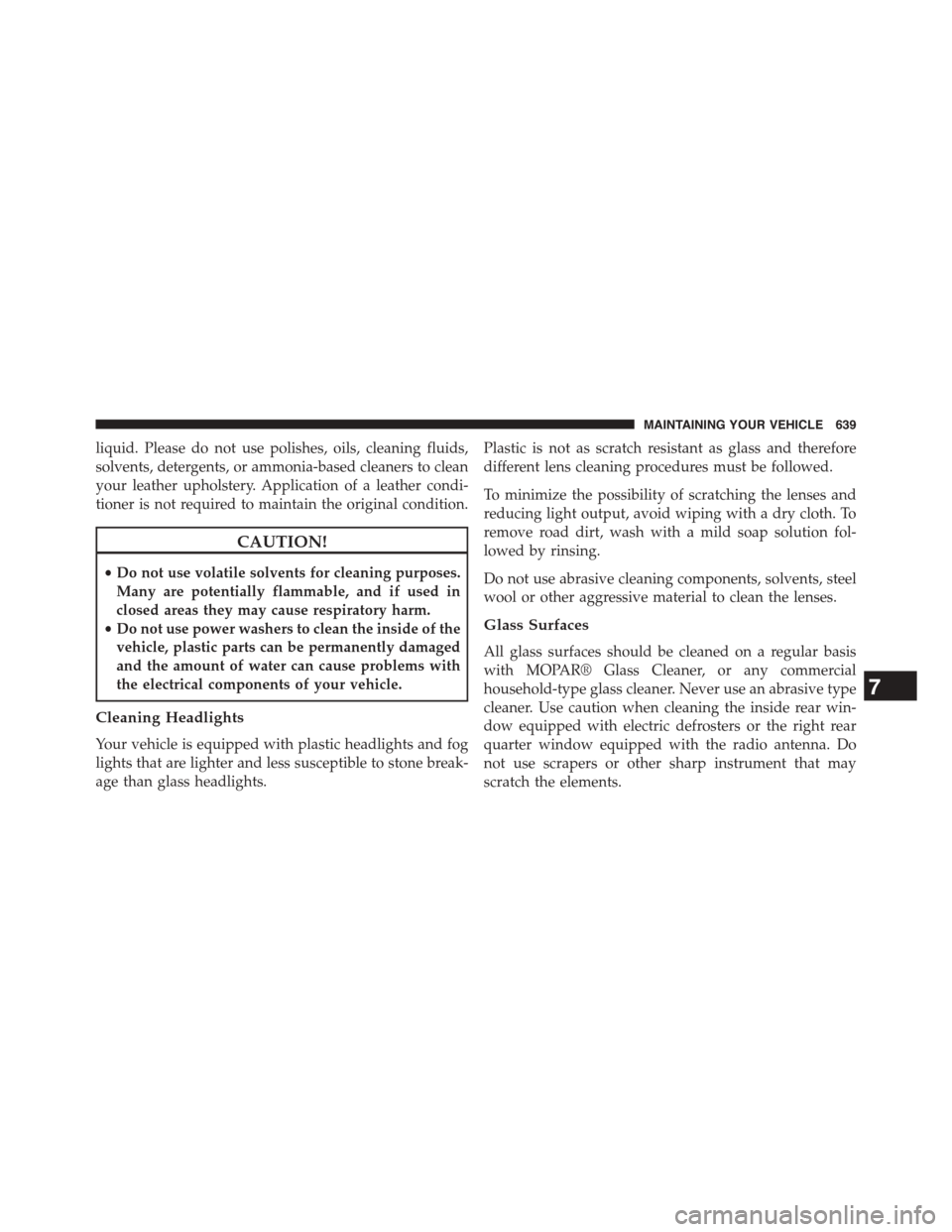
liquid. Please do not use polishes, oils, cleaning fluids,
solvents, detergents, or ammonia-based cleaners to clean
your leather upholstery. Application of a leather condi-
tioner is not required to maintain the original condition.
CAUTION!
•Do not use volatile solvents for cleaning purposes.
Many are potentially flammable, and if used in
closed areas they may cause respiratory harm.
•Do not use power washers to clean the inside of the
vehicle, plastic parts can be permanently damaged
and the amount of water can cause problems with
the electrical components of your vehicle.
Cleaning Headlights
Your vehicle is equipped with plastic headlights and fog
lights that are lighter and less susceptible to stone break-
age than glass headlights.
Plastic is not as scratch resistant as glass and therefore
different lens cleaning procedures must be followed.
To minimize the possibility of scratching the lenses and
reducing light output, avoid wiping with a dry cloth. To
remove road dirt, wash with a mild soap solution fol-
lowed by rinsing.
Do not use abrasive cleaning components, solvents, steel
wool or other aggressive material to clean the lenses.
Glass Surfaces
All glass surfaces should be cleaned on a regular basis
with MOPAR® Glass Cleaner, or any commercial
household-type glass cleaner. Never use an abrasive type
cleaner. Use caution when cleaning the inside rear win-
dow equipped with electric defrosters or the right rear
quarter window equipped with the radio antenna. Do
not use scrapers or other sharp instrument that may
scratch the elements.
7
MAINTAINING YOUR VEHICLE 639
Page 643 of 703
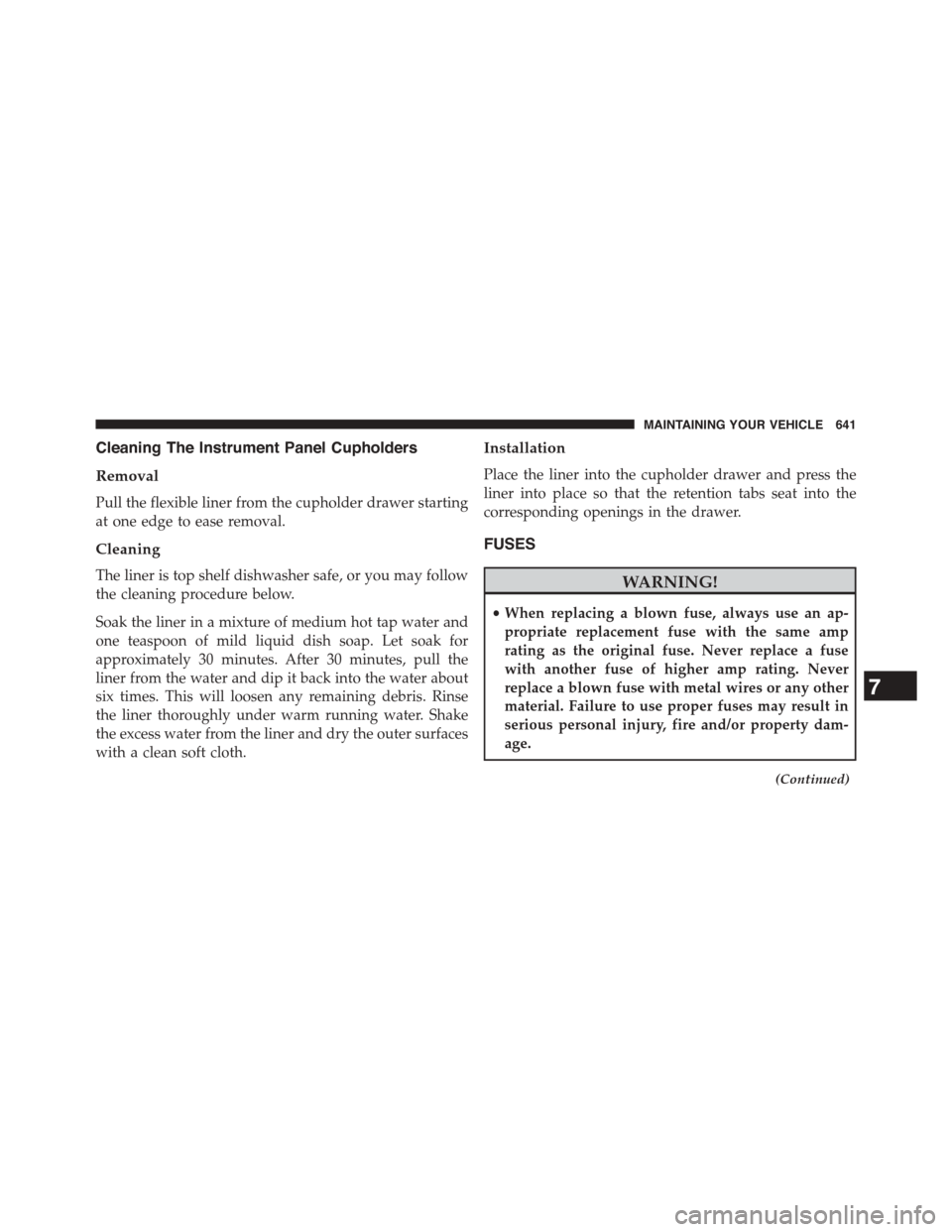
Cleaning The Instrument Panel Cupholders
Removal
Pull the flexible liner from the cupholder drawer starting
at one edge to ease removal.
Cleaning
The liner is top shelf dishwasher safe, or you may follow
the cleaning procedure below.
Soak the liner in a mixture of medium hot tap water and
one teaspoon of mild liquid dish soap. Let soak for
approximately 30 minutes. After 30 minutes, pull the
liner from the water and dip it back into the water about
six times. This will loosen any remaining debris. Rinse
the liner thoroughly under warm running water. Shake
the excess water from the liner and dry the outer surfaces
with a clean soft cloth.
Installation
Place the liner into the cupholder drawer and press the
liner into place so that the retention tabs seat into the
corresponding openings in the drawer.
FUSES
WARNING!
•When replacing a blown fuse, always use an ap-
propriate replacement fuse with the same amp
rating as the original fuse. Never replace a fuse
with another fuse of higher amp rating. Never
replace a blown fuse with metal wires or any other
material. Failure to use proper fuses may result in
serious personal injury, fire and/or property dam-
age.
(Continued)
7
MAINTAINING YOUR VEHICLE 641
Page 645 of 703
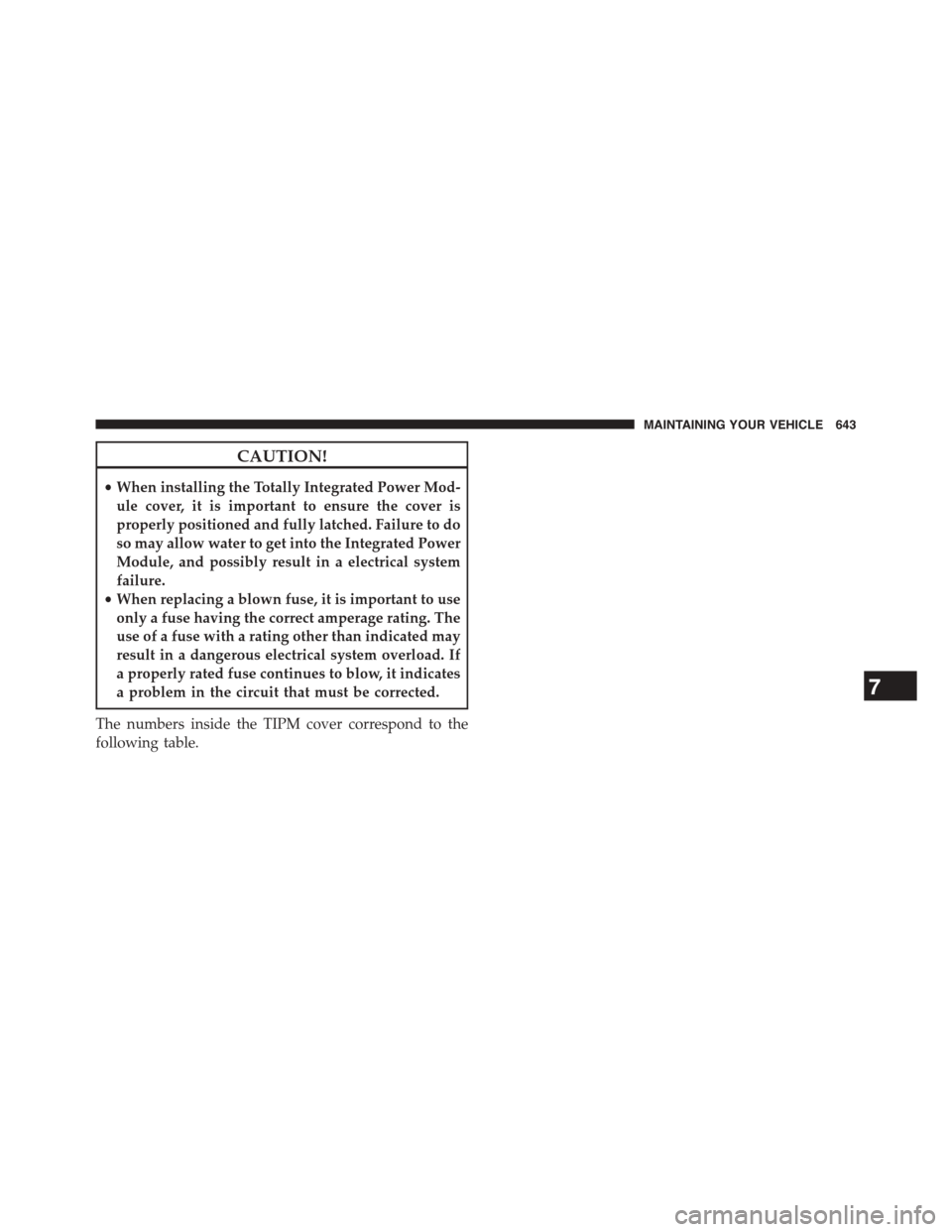
CAUTION!
•When installing the Totally Integrated Power Mod-
ule cover, it is important to ensure the cover is
properly positioned and fully latched. Failure to do
so may allow water to get into the Integrated Power
Module, and possibly result in a electrical system
failure.
•When replacing a blown fuse, it is important to use
only a fuse having the correct amperage rating. The
use of a fuse with a rating other than indicated may
result in a dangerous electrical system overload. If
a properly rated fuse continues to blow, it indicates
a problem in the circuit that must be corrected.
The numbers inside the TIPM cover correspond to the
following table.
7
MAINTAINING YOUR VEHICLE 643
Page 676 of 703
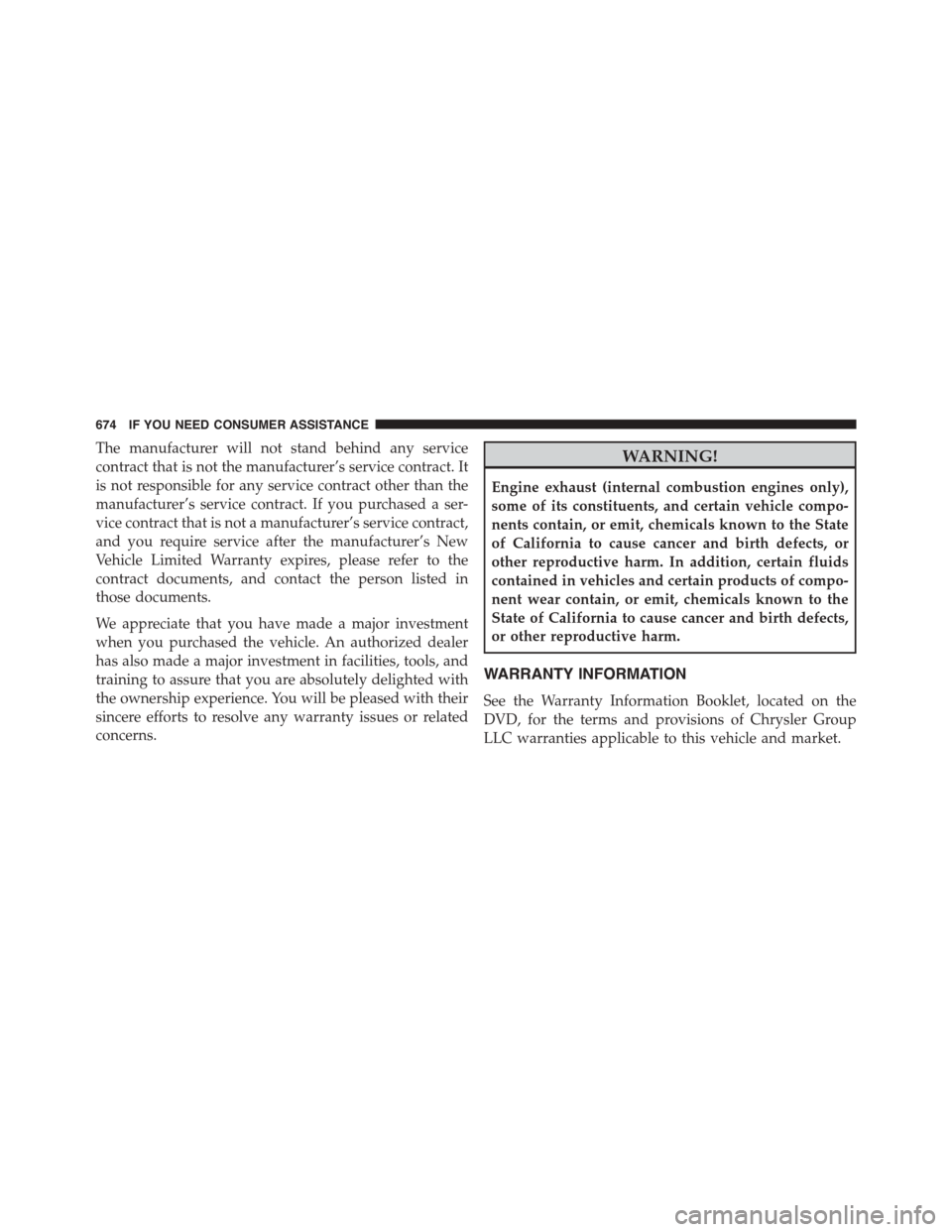
The manufacturer will not stand behind any service
contract that is not the manufacturer’s service contract. It
is not responsible for any service contract other than the
manufacturer’s service contract. If you purchased a ser-
vice contract that is not a manufacturer’s service contract,
and you require service after the manufacturer’s New
Vehicle Limited Warranty expires, please refer to the
contract documents, and contact the person listed in
those documents.
We appreciate that you have made a major investment
when you purchased the vehicle. An authorized dealer
has also made a major investment in facilities, tools, and
training to assure that you are absolutely delighted with
the ownership experience. You will be pleased with their
sincere efforts to resolve any warranty issues or related
concerns.
WARNING!
Engine exhaust (internal combustion engines only),
some of its constituents, and certain vehicle compo-
nents contain, or emit, chemicals known to the State
of California to cause cancer and birth defects, or
other reproductive harm. In addition, certain fluids
contained in vehicles and certain products of compo-
nent wear contain, or emit, chemicals known to the
State of California to cause cancer and birth defects,
or other reproductive harm.
WARRANTY INFORMATION
See the Warranty Information Booklet, located on the
DVD, for the terms and provisions of Chrysler Group
LLC warranties applicable to this vehicle and market.
674 IF YOU NEED CONSUMER ASSISTANCE
Page 680 of 703

WARNING!
The traction grade assigned to this tire is based on
straight-ahead braking traction tests, and does not
include acceleration, cornering, hydroplaning, or
peak traction characteristics.
Temperature Grades
The temperature grades are A (the highest), B, and C,
representing the tire’s resistance to the generation of heat
and its ability to dissipate heat, when tested under
controlled conditions on a specified indoor laboratory
test wheel. Sustained high temperature can cause the
material of the tire to degenerate and reduce tire life, and
excessive temperature can lead to sudden tire failure. The
grade C corresponds to a level of performance, which all
passenger car tires must meet under the Federal Motor
Vehicle Safety Standard No. 109. Grades B and A repre-
sent higher levels of performance on the laboratory test
wheel, than the minimum required by law.
WARNING!
The temperature grade for this tire is established for
a tire that is properly inflated and not overloaded.
Excessive speed, under-inflation, or excessive load-
ing, either separately or in combination, can cause
heat buildup and possible tire failure.
678 IF YOU NEED CONSUMER ASSISTANCE
Page 682 of 703
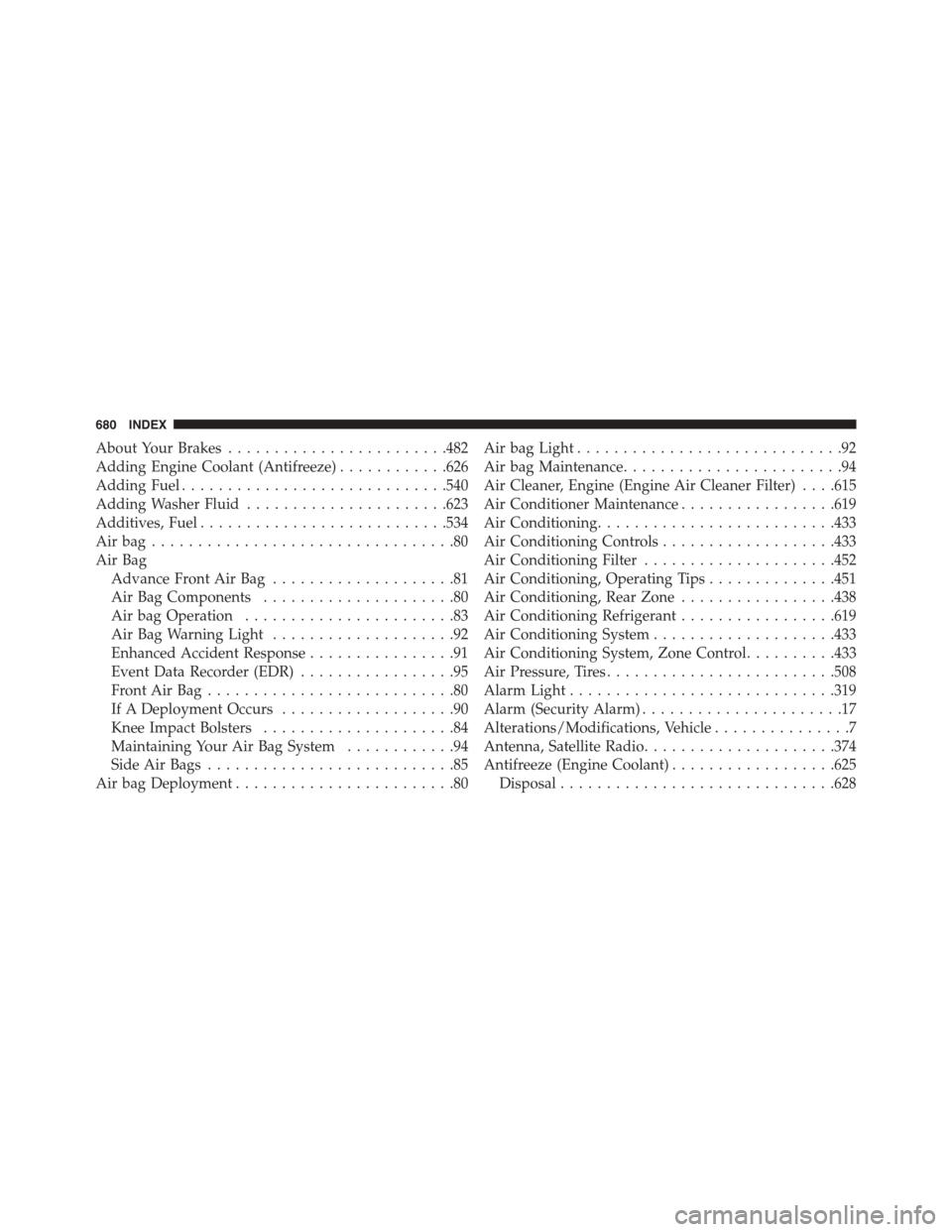
About Your Brakes........................482
Adding Engine Coolant (Antifreeze)............626
Adding Fuel.............................540
Adding Washer Fluid......................623
Additives, Fuel...........................534
Air bag . . . . . . . . . . . . . . . . . . . . . . . . . . . . . . . . .80
Air Bag
Advance Front Air Bag....................81
Air Bag Components.....................80
Air bag Operation.......................83
Air Bag Warning Light....................92
Enhanced Accident Response................91
Event Data Recorder (EDR).................95
Front Air Bag . . . . . . . . . . . . . . . . . . . . . . . . . . .80
If A Deployment Occurs...................90
Knee Impact Bolsters.....................84
Maintaining Your Air Bag System............94
Side Air Bags...........................85
Air bag Deployment........................80
Air bag Light.............................92
Air bag Maintenance........................94
Air Cleaner, Engine (Engine Air Cleaner Filter) . . . .615
Air Conditioner Maintenance.................619
Air Conditioning..........................433
Air Conditioning Controls...................433
Air Conditioning Filter.....................452
Air Conditioning, Operating Tips..............451
Air Conditioning, Rear Zone.................438
Air Conditioning Refrigerant.................619
Air Conditioning System....................433
Air Conditioning System, Zone Control..........433
Air Pressure, Tires.........................508
Alarm Light.............................319
Alarm (Security Alarm)......................17
Alterations/Modifications, Vehicle...............7
Antenna, Satellite Radio.....................374
Antifreeze (Engine Coolant)..................625
Disposal..............................628
680 INDEX
Page 687 of 703

Jump Starting..........................594
Overheating...........................561
Emission Control System Maintenance..........609
Engine
Air Cleaner...........................615
Block Heater..........................462
Break-In Recommendations................120
Checking Oil Level......................612
Compartment..........................607
Compartment Identification................607
Coolant (Antifreeze).....................624
Cooling..............................624
Exhaust Gas Caution.....................121
Flooded, Starting.......................460
Fuel Requirements......................531
Oil . . . . . . . . . . . . . . . . . . . . . . . . . . . . . . . . ..612
Oil Selection...........................613
Oil Synthetic..........................615
Overheating...........................561
Starting..............................459
Temperature Gauge......................322
Engine Oil Viscosity.......................614
Engine Oil Viscosity Chart...................614
Enhanced Accident Response Feature............91
Entry System, Illuminated....................20
Ethanol................................532
Event Data Recorder........................95
Exhaust Gas Caution.......................121
Exhaust System...........................121
Exterior Lights...........................125
Fabric Care..............................638
Filler Location Fuel........................318
Filters
Air Cleaner...........................615
Air Conditioning.......................452
Engine Oil............................615
Engine Oil Disposal.....................61510
INDEX 685